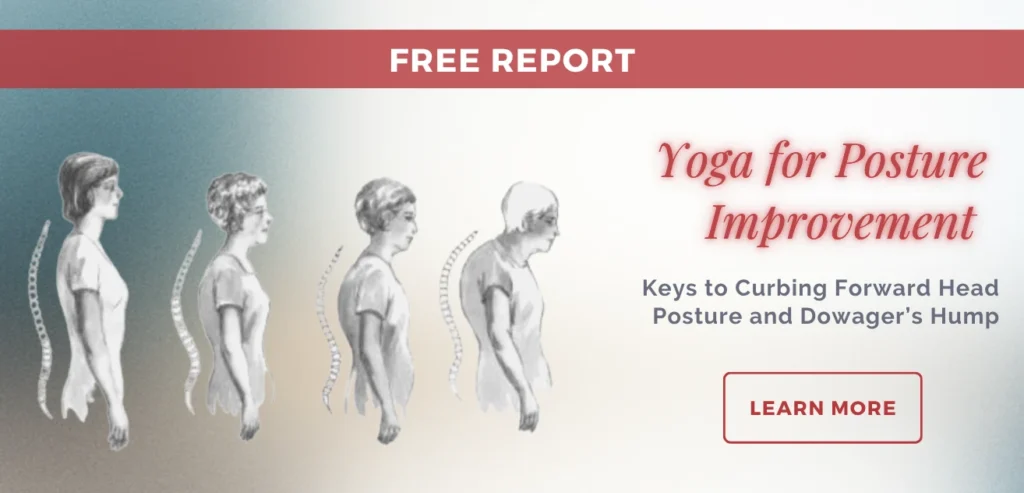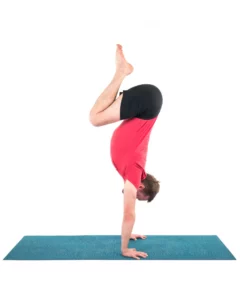The Trikonasana Foot and Knee Alignment Secret You Didn’t Learn in Yoga Teacher Training

Your teacher training probably covered Trikonasana foot and knee alignment. You probably learned that weight tends to roll to the outer foot and that you should cue pressing the big toe mound down because a lift of the inner foot is a common misalignment in Trikonasana. Does this sound about right?
But why does your weight roll to your outer foot in Triangle Pose? And is this really problematic or a “misalignment”?
When you examined Trikonasana knee and foot alignment, you may have learned that the inner foot lifts because you’re externally rotating your front hip. That is, turning the front thigh out pours more weight to the outer foot. That’s true, but it’s only part of the story.
A Quick Overview of Knee Anatomy in Trikonasana

Let’s say you’re teaching the common transition between Warrior II Pose (Virabhadrasana II) (shown above) and Trikonasana or between Side Angle Pose (Parsvakonasana) and Triangle. Either way, you’re moving from a bent knee to a straight one. When you straighten your leg, your knee executes a nifty maneuver called the “screw home mechanism.”
Sounds like a petulant teenager, doesn’t it? It’s actually an important gait element. And understanding the screw home mechanism can help you refine your Triangle Pose—as well as the way you cue this common asana.
As you straighten your leg, your shin bone rotates laterally relative to your thigh bone. Your shin bone spins toward the pinky-toe side of your foot. Your knee “screws home.” What role does this mechanism play in your day-to-day life?
When you walk, as you shift your weight onto your front leg, that knee straightens. As it straightens, the screw home mechanism rolls load to your outer foot—that’s the part of your foot that bears weight. Think of footsteps in the sand: you see the imprint of the outer, but not the inner foot, right?
The screw home mechanism is a natural—and useful—component of walking. But it gets a bad rap when it transfers weight to the outer foot in yoga asana, like Triangle Pose. We’ll have more to say about this criticism of “incorrect” foot alignment in Trikonasana, but let’s first get a clearer understanding of the screw home mechanism doing its thing as you straighten your knee.
Witness the Screw Home Mechanism in Action
First, we’ll need to identify an important bony landmark on your lower leg. Take your hand to your shin bone—the one you’d protect with a soccer shin guard. That’s your tibia. Trace the ridge of the tibia up toward your knee. Just below your knee, you’ll feel a round lump. That’s your tibial tuberosity. If you’re on your kneecap, you’re too high up.

The tibial tuberosity will be our guidepost as we observe the screw home mechanism.
Roll up your pants to see your knees and find a full-length mirror. Come into a Fierce Pose (Utkatsana), facing the mirror. Now, slowly straighten your legs to stand. As you straighten your knees, observe the bumpy tibial tuberosity. See how it glides outward, away from the midline?
If it’s difficult to see, you can use a colored marker to draw a large dot on the tibial tuberosity. Trace the dot with your knee bent. Then, watch the circle migrate as you straighten your legs.
The Screw Home Mechanism and Trikonasana Knee Alignment
The screw home mechanism is a useful gait element, as mentioned above. It’s also helpful in addressing common challenges in Trikonasana. Do you know how you always remind students to turn the front leg out to prevent the knee from rolling in? The screw home mechanism helps guide the knee outward toward the pinky side of the foot.
However, it also lifts the inner foot away from the mat.
The Big Takeaway: Tips for Teaching Trikonasana
The bottom line is that when weight rolls to the outer foot in Trikonasana, you’re not doing anything wrong or bad—your knee functions normally!
Understanding normal knee and shin function prevents us, when we’re teaching, from demonizing normal human movements or seeing them as incorrect. Yes, we can still cue pressing the big toe down, but now we have a more nuanced comprehension of why that side of the foot peels away from the floor. The weight shift to the outer foot is perfectly normal!
The next time you see a student’s inner foot escape the floor in a Triangle Pose, you might praise their wonderfully functional, efficient knee mechanics rather than correcting their alignment.
Also, read...
Yoga Anatomy: 3 Easy Steps to Hamstring Health
Yoga and Your Reticular Activating System
A Vagus Nerve Primer: 9 Reasons to Make Friends with Your Vagus Nerve
Related courses

Jennie Cohen, YACEP, E-RYT 500, started teaching yoga in New York in 2006 and now teaches aspiring teachers, experienced teachers, and movement enthusiasts all over the globe. Study with Jennie to learn anatomy in fun and practical ways, to build or refine your teaching skills, and to expand your movement repertoire. Jennie’s fascination with the body in motion and her studies of the texts that form yoga’s philosophical foundation infuse her teaching, making it both informative and transformative.




